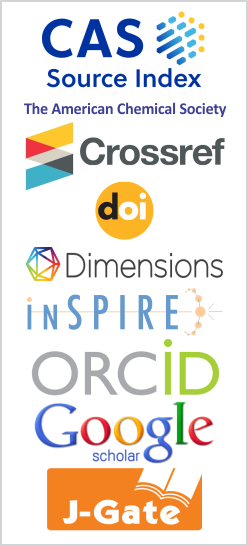Relativistic Many-body Calculations for Electric Dipole Moments in \(^{129}\)Xe, \(^{199}\)Hg, \(^{223}\)Rn, \(^{225}\)Ra and \(^{171}\)Yb Atoms
DOI:
https://doi.org/10.26713/jamcnp.v2i2.333Keywords:
Coupled-cluster theory, Nuclear Schiff moment, Tensor-pseudotensor interaction, CPviolation, Electron correlationAbstract
We present and compare the results of permanent electric dipole moments (EDMs) of various closed-shell atoms due to the nuclear Schiff moment (NSM) and the tensor-pseudotensor (T-PT) interactions between the atomic nuclei and electrons. In order to highlight the role of electron-correlation effects in obtaining accurate EDM results, we employ a number of relativistic many-body methods including coupled-cluster theory at different degrees of approximation. On combining our results obtained from the relativistic coupled-cluster (RCC) at the levels of singles and doubles excitations (CCSD method) with the available EDM measurements we obtain accurate bounds on the couplings \(S\) and \(C_T\) associated with the respective NSM and T-PT interactions. The most precise EDM measurement on \(^{199}\)Hg in combination with our CC results yield limits on the above couplings as \(S<1.45 \times 10^{-12}|e|\)fm\(^3\) and \(C_T < 2.09 \times 10^{-9}\) respectively. Further combining these bounds with the latest nuclear structure and quantum chromodynamics calculations we infer limits on the strong CP-violating parameter and for the combined up- and down- quark chromo-EDMs as \(|\bar{\theta}| < 1.1 \times 10^{-9}\) and \(|\widetilde{d}_u - \widetilde{d}_d| < 2.8 \times 10^{-26} |e|\)cm, respectively.Downloads
References
J. H. Christenson, J. W. Cronin, V. L. Fitch and R. Turlay, Phys. Rev. Lett. 13 (1964), 138.
K. Abe et al., Phys. Rev. Lett. 87 (2001), 091802.
B. Aubert et al., Phys. Rev. Lett. 87 (2001), 091801.
R. Aaij et al., Phys. Rev. Lett. 110 (2013), 221601.
L. D. Landau, Sov. Phys. JETP 5 (1957), 336.
I. B. Khriplovich and S. K. Lamoreaux, CP Violation without Strangeness, Electric Dipole Moments of Particles, Atoms and Molecules, (Springer, Berlin, 1997).
G. Luders, Ann. Phys. (N.Y.) 281 (2000), 1004.
S. M. Barr, Int. J. Mod. Phys. A 8 (1993), 209.
W. C. Griffith et al., Phys. Rev. Lett. 102 (2009), 101601.
T. Furukawa et al., J. Phys. Conf. Ser. 312 (2011), 102005.
A. Yoshimi et al., Phys. Lett. A 304 (2002), 13.
T. Inoue et al., Hyperfine Interactions (Springer Netherlands) 220 (2013), 59.
E. T. Rand et al., J. Phys. Conf. Ser. 312 (2011), 102013.
D. S. Weiss, Private communication.
D. Heinzen, Private communication.
J. Engel, M. J. Ramsey-Musolf and U. van Kolck, Prog. Part. Nucl. Phys. 71 (2013), 21.
V. V. Flambaum, I. B. Khriplovich and O. P. Sushkov, Nuc. Phys. A 449 (1986), 750.
M. Pospelov and A. Ritz, Ann. Phys. (N.Y.) 318 (2005), 119.
V. V. Flambaum and J. S. M. Ginges, Phys. Rev. A 65 (2002), 032113.
V. A. Dzuba, V. V. Flambaum and S. G. Porsev, Phys. Rev. A 80 (2009), 032120.
A. M. Maartensson-Pendrill, Phys. Rev. Lett. 54 (1985), 1153.
V. A. Dzuba et al., Phys. Rev. A 66 (2002), 012111.
K. V. P. Latha, D. Angom, B. P. Das and D. Mukherjee, Phys. Rev. Lett. 103 (2009), 083001.
Y. Singh, B. K. Sahoo and B. P. Das, Phys. Rev. A 89 (2014), 030502(R).
B. K. Sahoo, Y. Singh and B. P. Das, Phys. Rev. A 90 (2014), 050501(R).
Y. Singh and B. K. Sahoo, Phys. Rev. A 92 (2015), 022502.
S. Pal, M. D. Prasad and D. Mukherjee, Pramana 18 (1982), 261.
I. Shavitt and R. J. Bartlett, Many-Body Methods in Chemistry and Physics: MBPT and Coupled-Cluster Theory, p. 350, First Edition, Cambridge University Press, New York (2009).
Y. Singh and B. K. Sahoo, Phys. Rev. A 91 (2015), 030501.
Y. Singh, B. K. Sahoo and B. P. Das, Phys. Rev. A 88 (2013), 062504.
K. V. P. Latha and P. R. Amjith, Phys. Rev. A 87 (2013), 022509.
P. Fierlinger et al., Cluster of Excellence for Fundamental Physics, Technische Universität München (http://www.universe-cluster.de/fierlinger/xedm.html).
U. Schmidt et al. Collaboration of the Helium Xenon EDM Experiment, Physikalisches Institut, University of Heidelberg (http://www.physi.uni-heidelberg.de/Forschung/ANP/XenonEDM/Team).
V. F. Dmitriev and R. A. Senkov, Phys. Rev. Lett. 91 (2003), 21.
C. A. Baker et al., Phys. Rev. Lett. 97 (2006), 131801.
W. Dekens et al., JHEP 1407 (2014), 069.
M. Pospelov, Phys. Lett. B 530 (2002), 123.
R. H. Parker et al., Phys. Rev. Lett. 114 (2015), 233002.
N. Auerbach, V. V. Flambaum and V. Spevak, Phys. Rev. Lett. 76 (1996), 4316.
V. Spevak, N. Auerbach and V. V. Flambaum, Phys. Rev. C 56 (1997), 1357.
M. V. Romalis and E. N. Fortson, Phys. Rev. A 59 (1999), 4547.
J. Dobaczewski and J. Engel, Phys. Rev. Lett. 94 (2005), 232502.
J. Engel, M. J. Ramsey-Musolf and U. van Kolck, Prog. Part. Nucl. Phys. 71 (2013), 21.
W. Dekens et al., JHEP 1407 (2014), 069.
M. Pospelov, Phys. Lett. B 530 (2002), 123.
Downloads
Published
How to Cite
Issue
Section
License
Authors who publish with this journal agree to the following terms:- Authors retain copyright and grant the journal right of first publication with the work simultaneously licensed under a CCAL that allows others to share the work with an acknowledgement of the work's authorship and initial publication in this journal.
- Authors are able to enter into separate, additional contractual arrangements for the non-exclusive distribution of the journal's published version of the work (e.g., post it to an institutional repository or publish it in a book), with an acknowledgement of its initial publication in this journal.
- Authors are permitted and encouraged to post their work online (e.g., in institutional repositories or on their website) prior to and during the submission process, as it can lead to productive exchanges, as well as earlier and greater citation of published work.




